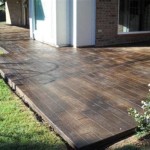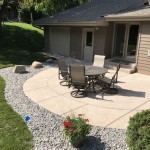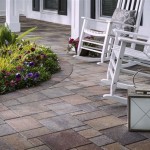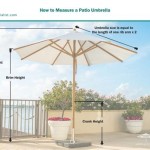How To Clean Up Old Concrete Patio Slabs
Concrete patios, while durable and long-lasting, are susceptible to accumulating dirt, stains, moss, and algae over time. Regular cleaning is crucial to maintain their appearance and prevent the development of slippery surfaces that can pose safety hazards. This article provides a comprehensive guide to cleaning old concrete patio slabs, covering various cleaning methods, necessary tools, and preventative measures.
Initial Assessment and Preparation
Before commencing any cleaning process, assessing the patio's condition is paramount. This involves identifying the types of stains present, the extent of moss or algae growth, and any existing damage to the concrete surface, such as cracks or chips. Understanding the problems will dictate the appropriate cleaning methods and solutions.
Begin by removing all furniture, potted plants, and other objects from the patio. This ensures accessibility to the entire surface and prevents damage to these items during the cleaning process. Thoroughly sweeping the patio using a stiff-bristled broom is the next step. This removes loose debris like leaves, twigs, dirt, and cobwebs. This initial sweep reduces the amount of organic matter that could interfere with the cleaning solution.
Protecting surrounding vegetation is essential. Concrete cleaners, especially those containing harsh chemicals, can damage plants and grass. Covering nearby plants with plastic sheeting or tarps prevents accidental exposure to cleaning solutions. Additionally, ensure proper drainage to avoid runoff from contaminating gardens or waterways.
Choosing the Right Cleaning Method
Several methods are available for cleaning concrete patio slabs, ranging from simple rinsing to using specialized cleaning solutions and pressure washers. The optimal method depends on the severity of the staining, the type of contaminants present, and the desired level of cleanliness.
Simple Rinsing: For patios with light dirt and dust buildup, a simple rinse with a garden hose may be sufficient. This method is environmentally friendly and requires minimal effort. Use a nozzle attachment to increase water pressure and effectively dislodge surface dirt. This is a good option for routine maintenance and preventative cleaning.
Soap and Water: For patios with moderate dirt and grime, a solution of mild soap and water can be effective. A dish soap or a specialized concrete cleaner can be used. Mix the soap with water according to the product instructions. Apply the solution to the patio surface using a mop or brush. Allow the solution to sit for a few minutes to loosen the dirt. Scrub the patio with a stiff-bristled brush to remove the remaining grime. Rinse thoroughly with clean water to remove all soap residue. Leftover soap can attract dirt and create a slippery surface. This method is suitable for general cleaning and removing everyday dirt.
Pressure Washing: Pressure washing is a powerful method for removing stubborn stains, dirt, moss, and algae. Pressure washers use high-pressure water to blast away contaminants from the concrete surface. However, care must be taken when using a pressure washer to avoid damaging the concrete. Use a wide-angle nozzle and maintain a safe distance from the surface. Start with a low-pressure setting and gradually increase it as needed. Avoid holding the nozzle in one place for too long, as this can etch the concrete. Pressure washing can effectively remove deep-seated stains and restore the patio's appearance. However, it is often more time consuming than other methods and requires the appropriate safety gear.
Chemical Cleaners: For patios with persistent stains, such as oil, grease, or rust, chemical cleaners may be necessary. Various concrete cleaners are available, each designed to target specific types of stains. Always read and follow the manufacturer's instructions carefully. Wear appropriate protective gear, including gloves, eye protection, and a respirator, to avoid exposure to harmful chemicals. Apply the cleaner to the affected area and allow it to sit for the recommended time. Scrub the area with a stiff-bristled brush and rinse thoroughly with clean water. Neutralizing the chemical cleaner after application is also recommended to prevent damage to the concrete. Disposal of the runoff from using chemical cleaners must follow local laws and regulations in order to prevent environmental contamination.
Addressing Specific Stains and Issues
Different types of stains require different approaches. Understanding the nature of the stain allows for the selection of the most effective cleaning method.
Oil and Grease Stains: Oil and grease stains are common on patios used for grilling or parking vehicles. Absorbent materials such as cat litter, cornstarch, or baking soda can be used to absorb the excess oil. Apply the absorbent material to the stain and let it sit for several hours or overnight. Sweep up the absorbent material and dispose of it properly. After removing the excess oil, use a degreasing cleaner specifically designed for concrete. Apply the cleaner to the stain, scrub with a stiff-bristled brush, and rinse thoroughly. For stubborn stains, repeat the process or use a pressure washer with a degreasing solution.
Rust Stains: Rust stains can be caused by metal objects left on the patio. A rust remover specifically formulated for concrete is the best option for removing these stains. Follow the manufacturer's instructions carefully and wear appropriate protective gear. Apply the rust remover to the stain, let it sit for the recommended time, and scrub with a stiff-bristled brush. Rinse thoroughly with clean water. Citric acid or vinegar can also be used as a natural rust remover. Apply the acid to the stain, let it sit for 30 minutes, and scrub with a brush. Rinse thoroughly with water.
Moss and Algae Growth: Moss and algae thrive in damp, shaded areas and can make the patio slippery. A solution of bleach and water can be used to kill moss and algae. Mix one part bleach with ten parts water. Apply the solution to the affected area and let it sit for 15-20 minutes. Scrub the area with a stiff-bristled brush and rinse thoroughly with clean water. A pressure washer can also be used to remove moss and algae, but be careful not to damage the concrete. Specialized moss and algae killers are also available; follow the product instructions carefully. Proper ventilation is vital when using bleach or chemical moss killers.
Efflorescence: Efflorescence is a white, powdery deposit that can appear on the surface of concrete. It is caused by soluble salts migrating to the surface and depositing as water evaporates. Dry brushing can remove light efflorescence. For heavy efflorescence, use a commercial efflorescence remover. Follow the manufacturer's instructions carefully and rinse thoroughly with clean water. Addressing the source of the moisture that is causing the efflorescence is essential for preventing its recurrence.
Preventative Measures and Maintenance
Preventing future stains and maintaining the patio's cleanliness is crucial for prolonging its lifespan and reducing the frequency of thorough cleanings.
Sealing the Concrete: Applying a concrete sealer provides a protective barrier against water, oil, and other contaminants. Sealing the concrete helps to prevent stains from penetrating the surface and makes cleaning easier. Choose a sealer specifically designed for concrete patios and follow the manufacturer's instructions carefully. Clean the patio thoroughly before applying the sealer. Apply the sealer evenly using a roller or sprayer. Allow the sealer to dry completely before using the patio. The frequency of resealing depends on the type of sealer and the amount of traffic the patio receives.
Regular Sweeping and Rinsing: Regularly sweeping the patio removes loose dirt and debris, preventing it from becoming embedded in the concrete. Rinsing the patio with a garden hose helps to remove surface dirt and prevent the buildup of stains. A quick sweep and rinse once a week can significantly reduce the need for more extensive cleaning.
Prompt Stain Removal: Addressing stains as soon as they occur is crucial for preventing them from becoming permanent. Clean up spills immediately using absorbent materials and appropriate cleaning solutions. The longer a stain sits, the harder it will be to remove. Keeping a cleaning kit with essential supplies readily available can facilitate prompt stain removal.
Proper Drainage: Ensuring proper drainage prevents water from pooling on the patio surface, which can contribute to the growth of moss and algae. Make certain the patio is sloped slightly to allow water to run off. Clear any debris from drains and gutters to prevent water from backing up. Consider installing a drainage system if water pooling is a persistent problem.
By understanding the composition of the concrete slab, how to correctly assess and prepare it and choosing the right cleaning method and solutions, most patio surfaces can be restored with a good outcome. Regularly maintaining good habits such as sealing, sweeping and rinsing concrete patio slabs will ensure its longevity.

How To Clean Patio Slabs Minster Paving

How To Remove Your Concrete Patio Dumpsters Com

How To Clean Paving Slabs With Bleach Water Directory

How To Clean Paving Slabs With Bleach Water Directory

How To Clean Patio Slabs Make Your Sparkle For Spring With Three Household Items Express Co

Best Tips On Cleaning Patio Slabs How To Get Rid Of Algae

Removing A Concrete Patio By Hand Delineate Your Dwelling

Re Jointing A Patio Or Driveway Pavingexpert

Best Way To Clean A Concrete Patio Chalking Up Success

Diy Miracle Concrete Patio Cleaner I Should Be Mopping The Floor
Related Posts








